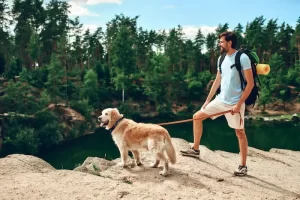
Cesar Millan, a renowned expert in dog behavior and training, has gained widespread recognition for his exceptional understanding of canine psychology and effective training techniques. Cesar has written several New York Times best-selling books about dog obedience and rehabilitation. However, it’s likely you know him best from his TV shows, which include The Dog Whisperer With Cesar Millan and Leader of the Pack. Throughout his career training dogs, Cesar Millan has learned a lot about dog psychology and has used this to create dog training best practices that work. Millan refers to these best practices when training canines in his dog psychology center.
Creating a happy dog means understanding its behavior problems and addressing them appropriately. To create a well-behaved dog, you must understand dog psychology and how it differs from the way humans think. That’s why we’ve created this extensive list of common dog behaviors and their solutions, according to the Cesar Millan dog training best practices.
The Basics of Cesar Millan’s Dog Training Philosophy
Cesar Millan has spoken about having a “pet culture shock” when he first came to America from Mexico with a dream of dog training. But, after speaking with pet owners and witnessing how people interact with their dogs, he decided his approach would be more about training people and rehabilitating dogs.
One of Cesar’s most critical aspects is ensuring the dog owner’s energy is calm and assertive. According to Millan, the energy you put out as the pack leader can have psychological effects on domestic dogs, whether positive or negative. Millan adds, “When we get fearful, anxious or overly affectionate, we trigger that energy in dogs.”
Recognizing energy is a fundamental part of how dogs communicate with each other and subsequently, how they communicate with you. But dogs are pack animals, and it’s your job to be the pack leader. What this means is that your dog will look to you for cues on how to feel and what to do. Although providing calm and assertive energy is crucial, there’s more to it than that. You’ll want to learn about dog psychology and how this can be used to create a happy dog or a well-behaved dog.
According to Cesar Millan, having a pack leader mentality means understanding the hierarchy of your dog’s needs. Exercise, discipline, and affection are all important but should be placed in that exact priority hierarchy. Millan uses this hierarchical approach at his dog psychology center and in The Dog Whisperer With Cesar Millan.
Common Dog Behavior Problems and Solutions
Certain behavior problems are common among domestic dogs. While these are best headed off in puppy training, fixing these behaviors later to create the perfect dog is always possible. Below, we’ve listed some of the most common dog behavior problems and their solutions, according to Cesar Millan.
Barking
Barking is a way dogs communicate with one another. However, excessive barking can quickly become a nuisance. Common reasons for excessive barking include territorial problems, pain, illness, and separation anxiety. But the top reason dogs bark too much? Boredom.
Cesar’s rules for managing excessive barking are straightforward. First, you need to psychologically and physically engage with your dog every day. Start by taking your dog on a long walk at least once daily, in addition to encouraging backyard exercise time. Exercise is one of the foundations of training at Cesar’s dog psychology center. Other tips for curing excessive barking include setting clear boundaries and remaining consistent in showing your dog you want it to behave.
Chewing
Destructive chewing happens because of hunger, separation anxiety or boredom. To redirect your dog from destructive chewing, the dog whisperer says to remain calm and correct your dog using basic commands. You’ll want to be consistent and work toward redirecting your dog without a treat. Practice basic commands such as “leave it” and “sit” frequently.
Most importantly? Use your energy and body language to claim the object your dog is chewing. Since chewing is an integral part of a dog’s basic needs, look for safe chew toys to fill this need for it.
Digging
For dogs, digging is a form of exercise and distraction. For certain breeds, the instinct to dig is a strong one. Cesar Millan says that one option to prevent unwanted digging is to have a special place where your dogs can dig. This helps them burn off excess energy while engaging in something that feels instinctually right to them.
But what if you don’t want your dog to dig at all or don’t have a space to let it? You can fulfill your dog’s needs by providing it with more exercise. For high-energy dogs, consider running, swimming, and hiking. Only by draining all your dog’s pent-up energy will you be able to stop it from destructive digging.
Separation Anxiety
Separation anxiety is one of the most common complaints people have. What they’re describing is a series of symptoms that make the dog appear stressed when left at home alone. Symptoms of separation anxiety might include:
- Excessive salivation
- Loud, ongoing barking
- Destructive of home, property, and items
- Scratching at the floors, doors, and walls
- Attempting to escape from rooms, crates, and yards
Most people would be shocked to learn that not all separation anxiety is true separation anxiety, which causes your dog to experience true stress when its human leaves. Sometimes, the problem is actually simulated separation anxiety, which is a learned behavior that often manifests itself when a dog lacks self-control and strong leadership.
Separation anxiety, simulated or true, is best headed off with puppy training, as it’s harder to fix in adult dogs. You’ll need to teach your dog how to be quiet and settle down (preferably in a crate), starting for short periods and slowly working up to longer intervals. Reward patience and calmness instead of providing your dog with negative attention. When your dog is out of its crate and with you, don’t provide it with constant attention. Instead, let it entertain itself with its toys. Over time, your dog will stop showing signs of separation anxiety.
Leash Pulling
The reasons behind leash pulling boil down to a lack of basic obedience training. Combating this means consistently working with your dog on basic obedience commands. Use rewards and affection to motivate your dog to obey your commands. While you can start with treats at first, you’ll want to slowly wean your dog away from treats as it masters walking on the leash and other basic commands. Using tools such as assertive energy and the Halo Collar can help in your training efforts.
Aggression
There are two root causes of aggression: frustration and dominance. Frustration generally comes from a lack of exercise. Dominance requires that the dog have a strong, calm leader to help it overcome aggression. Some dog breeds are more prone to aggression than others, but every dog can become aggressive.
The solution is simple at its core but can take a lot of time and patience to master. Most importantly, you need to use your calm, assertive energy to show your dog that you are the pack leader, not it. You shouldn’t be fearful when your dog begins to bark, growl or bare its teeth. Although fear is a natural response to this dog posturing, it allows the dog to remain in control.
Second, provide your dog with enough exercise to burn off that frustrated or fearful energy. Backyard exercise can be a great supplement, but it isn’t enough for most dogs. Instead, they need long walks or runs to satisfy their needs. With an aggressive dog, walks can be challenging, so you’ll first want to begin with leash training and basic commands.
Additional Tips for Success
A few tips for success can be applied to all dog problems and are crucial for long-term success. These include:
- Consistency: Dogs thrive on consistency, so you can’t be indecisive or allow problem behavior to happen sometimes. Instead, apply Cesar Millan’s dog training techniques and stick with them permanently. This allows your dog to know what you expect from it and gives it the structure it needs as a pack animal.
- Patience: Having patience and understanding when working with your dog can go a long way. Some dogs may learn faster than others, but it doesn’t help to get frustrated if your dog is a slow learner. Eventually, regularly working with your problem dog can turn it into the perfect dog.
- Adaptation: It’s important to take your dog’s unique personality and needs into consideration when training. Adapt your style as necessary. If you need help with this, it may be beneficial to reach out to a professional dog trainer.
Conclusion
Most common dog problems have straightforward dog behavior solutions. By providing adequate exercise and consistent training with a calm, assertive personality, you can fix most of your dog’s problem behaviors. We encourage you to use Cesar’s rules when training your dog since they’re based on dog psychology and have proven to work.
Need some additional support in your dog training efforts? Check out the Halo Collar, which is equipped with a wireless GPS fence to help establish boundaries for your dog. Using sound emission technology, the Halo Collar reaffirms boundaries and effortlessly provides assistance in establishing you as the pack leader. Learn more about the Halo Collar today.






